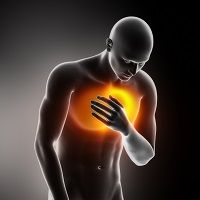Article
Chest Pain More Frequent in Patients with Depression
Author(s):
Even in the absence of coronary artery disease, patients with depression appear to experience more frequent chest pain than patients without depression.

Even in the absence of coronary artery disease, patients with depression appear to experience more frequent chest pain than patients without depression, according to study findings presented on August 31, 2015 by Salim S. Hayek, MD, a cardiology fellow in the clinical investigator track at Emory University School of Medicine, at the European Society of Cardiology annual congress. The findings suggest that pain and depression may share a common neurochemical pathway.
“Depression is a common and well-recognized risk factor for the development of heart disease,” said Hayek. “Patients with known heart disease and depression tend to experience chest pain more frequently. However, until now, it was not known whether that association was dependent on underlying coronary artery disease.”
To assess whether depression is associated with chest pain independently of underlying coronary artery disease, Hayek and colleagues enrolled 5,825 adults from the Emory Cardiovascular Biobank—a prospective registry of patients undergoing cardiac catheterization at three Emory Healthcare sites in Atlanta—between 2004 and 2013. Study participants had an average age of 63 years, 65% were men, and 22% were African Americans. Before cardiac catheterization, participants completed the Patient Health Questionnaire (PHQ-9) in order to assess depressive symptoms, as well as the Seattle Angina Questionnaire in order to assess chest pain frequency in the previous month. These questionnaires were repeated at 1 and 5 years post-procedure. Angiograms were used to determine the presence and, if applicable, severity of coronary artery disease.
The study investigators found that depression severity according to the PHQ-9 was independently associated with chest pain frequency, suggesting that patients with more severe depression had more frequent chest pain, and vice versa. Mild depression was even found to be associated with more frequent chest pain, when compared with no depression. The study findings remained true even after adjusting for coronary artery disease severity, age, gender, race, and traditional cardiovascular risk factors, including smoking, elevated BMI, elevated blood pressure, and elevated blood lipid levels.
Regardless of gender, patients with depression were three times more likely to experience increased rates of chest pain than those without depression. Interestingly, revascularization did not improve chest pain frequency at 1 year follow-up for patients with depression.
“We found that depression is strongly associated with the frequency of chest pain in adults with and without underlying coronary artery disease, and that patients with depression and heart disease did not have an improvement in their chest pain frequency even after coronary intervention,” said Hayek. “One possible explanation for our findings is that pain and depression share a common neurochemical pathway.
“Although depression is established as a risk factor for heart disease, there are no clear recommendations in the US for depression screening in patients with cardiovascular disease. ESC prevention guidelines recommend assessing patients for depression to prevent cardiovascular disease. Although our findings do not establish causality, they do suggest that depression is an important confounder of the relationship between chest pain and heart disease. Screening for depression in patients presenting with chest pain should be considered, and studies examining the effect of appropriate anti-depressive therapy on chest pain are needed.
“The fact that chest pain frequency at follow-up was decreased in patients whose depressive symptoms improved indicates that treating depression may help alleviate chest pain, after obstructive coronary artery disease as a cause of chest pain has been ruled out. This needs to be confirmed in randomized controlled trials.”



